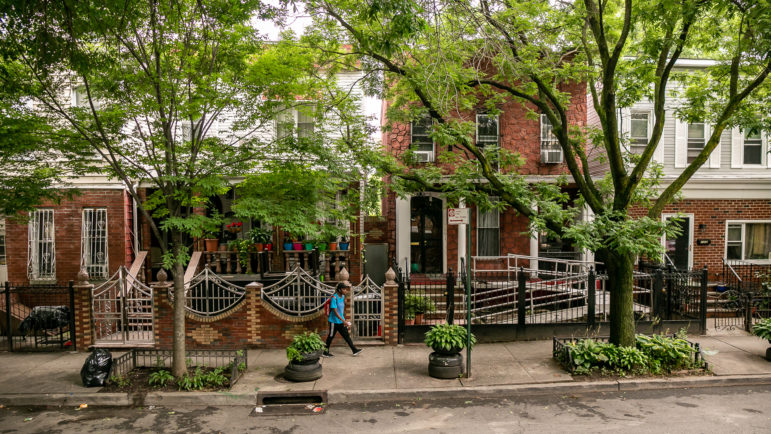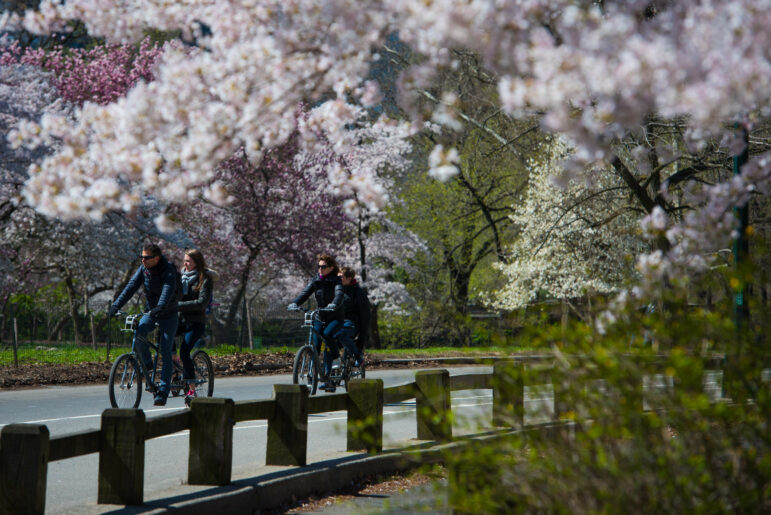A staff of just 302 people tend to a crop of over 865,000 trees across the city. Adams’ preliminary budget aims to slash $46 million from the Parks Department, which environmentalists fear signals a step back in the mayor’s promise to keep New York City’s canopy alive and growing.

Adi Talwar
A tree-lined street in Bushwick, Brooklyn.Lea la versión en español aquí
In June of last year, the mayor’s office approved the highest funding for tree planting in half a decade, allowing the Parks and Recreation Department to plant 20,000 trees a year for the next four years. But environmentalists worry that cuts signaled in the mayor’s preliminary budget and an already short staff will make it difficult to not only reach that goal, but to maintain the crop of over 865,000 trees the Parks Department currently oversees.
When Mayor Eric Adam released his preliminary budget proposal for Fiscal Year 2024 on Jan. 12, he set aside nearly $583 million for Parks. The amount is $46 million lower than the $629 million allocated for the current budget, and once again fails to fulfill Adams’ campaign promise of dedicating 1 percent of the city’s total $102.7 billion budget to the Parks Department.
For forestry, horticulture and natural resources, the preliminary funds total $34.15 million. The division includes 302 staff members—not enough, advocates say, to adequately manage the 22,000 acres of the city’s 42,656 acres of tree canopy the unit oversees.
“The Parks Department is too understaffed in its forestry division to help take care of our city’s trees,” Adam Ganser, executive director of the advocacy group New Yorkers for Parks, told City Limits.
There are currently 4,235 Parks employees and 426 vacant positions agency-wide, the department said in an email. While last year’s $629 million budget was one of the highest allocation of funds made to Parks in the city’s history, Ganser said the new preliminary budget and staff vacancies signify “a step backward.”
The Parks Department is no stranger to budget limitations: the de Blasio administration slashed $84 million from the department for the 2021 fiscal cycle, leaving many green spaces around the city covered in trash from lack of upkeep. Ganser warns the city’s trees could suffer a similar fate.
“We are going to end up in a really difficult situation very soon if we’re not able to maintain them. The trees will not survive, and then the money that we’re putting into planting [new trees] is just wasted,” Ganser said. “Elected leaders like to build things, they like to plant things, but they don’t like to maintain them. There’s no ribbon cutting for maintenance.”
In an emailed statement, Jennifer Greenfeld, deputy commissioner for environment and planning at Parks, said the agency is committed to its tree care.
“As the stewards of nearly half of the City’s urban forest, it’s our goal to protect and expand this vital natural resource as much, and as equitably as possible,” Greenfeld said.

Michael Appleton/Mayoral Photography Office.
A lifetime commitment
But protecting the city’s trees is no easy feat.
The forestry division of the Parks Department is responsible for every aspect of the tree’s life, from selecting the site where it will be planted, to the procurement, design, and installation of each sapling, to managing their upkeep as they grow.
When it comes to tending to trees on city streets, a contractor is usually hired to do the planting. That contractor provides a guarantee that covers taking care of the trees for the first two years, including replacing them if they die. Once those two years are up, the Parks Department takes over. New Yorkers can report a need for tree maintenance by calling the city’s helpline service 311; the Parks Department also carries out infrequent inspections.
“Each tree on the streetscape of New York City is visited once every seven to 10 years to determine if it needs pruning or some kind of tree assistance or not,” said Bram Gunther, who was chief of forestry, horticulture and natural resources for the Parks Department from 2011 to 2015.
Gunther started as a park ranger in 1991 and stayed in the department in various roles until his retirement in 2019. Well versed in how things are run, he believes the forestry division has a good system in place, but a limited staff.
“Is there an abundance of staff to take care of nature in New York City? No. Is there enough? Probably just enough,” Gunther told City Limits.
The city makes it work by relying heavily on volunteer groups to keep the canopy alive and thriving. One such group is Trees New York, a non-profit with more than 2,000 active volunteers who cultivate the soil, prune, clear out weeds, remove litter, and tend to damaged branches across the Big Apple.
Their Executive Director, Nelson Villarrubia, said civic participation is important, but also believes the city needs to invest more in maintenance. “If you don’t invest in maintenance you’re not protecting the huge cost of planting more trees. So you need that side of it, or it’s not going to be effective,” Villarubia said.
A faster planting pace
Sarah Charlop-Powers, executive director of Natural Areas Conservancy, says the key to a thriving canopy is to “invest in sufficient workforce and job creation” for tree upkeep while securing enough funds for “the planting of new trees, which is also hugely important.”
Her non-profit joined a coalition of environmental groups called Forest for All in championing the goal of achieving 30 percent canopy cover in New York City by 2035. The city had approximately 22 percent tree canopy when the most recent census was conducted in 2017.
“In order to reach that ambitious goal there would need to be a higher level of investment and a faster pace of planting,”Charlop-Powers adds.
According to the Parks Department, the average value of each tree is $3,130. That figure “includes the cost of design, the tree, excavation, planting, supervision, one year establishment (including watering and weeding), guarantee, and administration.”
Last year, all five borough presidents called on Mayor Adams to plant one million trees by 2030 at an estimated cost of $500 million.
Today, New York City has roughly 7 million trees, according to a recent Nature Conservancy report. That’s fewer than one tree for each of its 8.8 million residents. The Parks Department said in an email that more than 13,000 street trees were planted in fiscal year 2022, which ended in July, up significantly from prior years; more than 17,000 additional trees were planted in parks during that same period, city data shows.
During the first four months of current fiscal year 2023, Parks planted 2,748 trees in total, down from 5,075 in the same period the year before, according to the preliminary Mayor’s Management Report, which attributed the decline to the timing of planting season and “ongoing forest restoration contracts.”
But environmental groups say the city has the capacity to go further.
A study launched in December by the Nature Conservancy said New York City can double its tree canopy from the 22 percent recorded in the latest 2017 tree census to 42 percent, without moving buildings, roads and other land uses. Trees can be planted anywhere that have a greater footprint than about 25 square feet, with the exception of places like airports, cemeteries or individual properties, according to the Nature Conservancy.
Adding trees provide benefits like battling urban heat waves by lowering temperatures, and reducing stormwater runoff as they capture and store rainfall in the canopy that then evaporates naturally into the atmosphere.
But most importantly, green spaces are essential in the fight against climate change. A recent study published by researchers at the City University of New York found that when greenery in the Big Apple blooms during spring and summer, it absorbs as much as 40 percent of the human-caused carbon emissions in the New York City area.









One thought on “Mayor Adams Promised 20,000 Trees a Year. But Budget Cuts Threaten Progress”
What happened to the million trees that were planted in the Bloomberg and De Blasio administrations? Did 150,000 die already? Or are you not counting trees in parks?